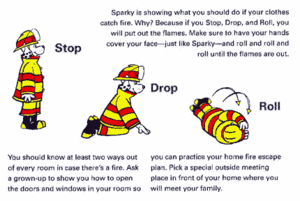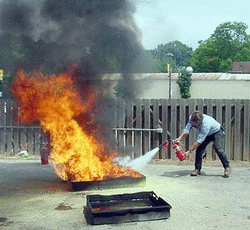There are two basic type of smoke detectors:
* Ionization detectors - Ionization detectors contain radioactive material that ionizes the air, making an electrical path. When smoke enters, the smoke molecules attach themselves to the ions. The change in electric current flow triggers the alarm. The radioactive material is called americium. It's a radioactive metallic element produced by bombardment of plutonium with high energy neutrons. The amount is very small and not harmful.
* Photo-electric detectors - These type of detectors contain a light source (usually a bulb) and a photocell, which is activated by light. Light from the bulb reflects off the smoke particles and is directed towards the photocell. The photocell then is activated to trigger the alarm.
Choosing a smoke detector
When choosing a smoke detector, there are several things to consider.
Think about which areas of the house you want to protect, where fire would be most dangerous, how many you will need, etc.
Fire Departments recomends that every home have a smoke detector outside each sleeping area (inside as well if members of the household sleep with the door closed) and on every level of the home, including the basement.
The National Fire Alarm code requires a smoke detector inside each sleeping area for new construction.
On floors without bedrooms, detectors should be installed in or near living areas, such as dens, living rooms or family rooms.
Smoke detectors are not recommended for kitchens.
The safest bet is to have both kinds or a combination detector with a battery back up.
Be sure to check for a testing laboratory label on the detector.
It means that samples of that particular model have been tested under operating conditions.
Check to see if it is easy to maintain and clean...
Installation
The placement of smoke detectors is very important.
Sleeping areas need the most protection.
One detector in a short hallway outside the bedroom area is usually adequate.
Hallways longer than 30 feet should have one at each end.
For maximum protection, install a detector in each bedroom.
Be sure to keep the detector away from fireplaces and wood stoves to avoid false alarms.
Place smoke detectors at the top of each stairwell and at the end of each long hallway. Smoke rises easily through stairwells.
If you should put a smoke detector in your kitchen, be sure to keep it away from cooking fumes or smoking areas.
Proper mounting of a smoke detector also is important.
You can mount many detectors by yourself, but those connected to your household wiring should have their own separate circuit and be installed by a professional electrician.
If you mount your detector on the ceiling, be sure to keep it at least 18 inches away from dead air space near walls and corners.
If you mount it on the wall, place it six to 12 inches below the ceiling and away from corners. Keep them high because smoke rises.
Never place them any closer than three feet from an air register that might recirculate smoke.
Don't place them near doorways or windows where drafts could impair the detector operation.
Don't place them on an uninsulated exterior wall or ceiling as temperature extremes can affect the batteries.
Maintenance
Keeping smoke detectors in good condition is easy.
Be sure to replace the batteries every year or as needed.
Most models will make a chirping, popping or beeping sound when the battery is losing its charge.
When this sound is heard, install a fresh battery, preferably an alkaline type.
Replace bulbs every three years or as needed.
Keep extras handy.
Check the smoke detector every 30 days by releasing smoke or pushing the test button.
Clean the detector face and grillwork to remove dust and grease.
Never paint a smoke detector as it will hamper its function.
Check your detector if you've been away from home.
If you're looking for a novel gift for somebody, consider giving them a smoke detector. It makes for an interesting gift that can save lives and it shows that you care.

FIRE EXTINGUISHER: 101 (fyi)
http://www.icmag.com/ic/showthread.php?t=16728

* Ionization detectors - Ionization detectors contain radioactive material that ionizes the air, making an electrical path. When smoke enters, the smoke molecules attach themselves to the ions. The change in electric current flow triggers the alarm. The radioactive material is called americium. It's a radioactive metallic element produced by bombardment of plutonium with high energy neutrons. The amount is very small and not harmful.
* Photo-electric detectors - These type of detectors contain a light source (usually a bulb) and a photocell, which is activated by light. Light from the bulb reflects off the smoke particles and is directed towards the photocell. The photocell then is activated to trigger the alarm.
Choosing a smoke detector
When choosing a smoke detector, there are several things to consider.
Think about which areas of the house you want to protect, where fire would be most dangerous, how many you will need, etc.
Fire Departments recomends that every home have a smoke detector outside each sleeping area (inside as well if members of the household sleep with the door closed) and on every level of the home, including the basement.
The National Fire Alarm code requires a smoke detector inside each sleeping area for new construction.
On floors without bedrooms, detectors should be installed in or near living areas, such as dens, living rooms or family rooms.
Smoke detectors are not recommended for kitchens.
The safest bet is to have both kinds or a combination detector with a battery back up.
Be sure to check for a testing laboratory label on the detector.
It means that samples of that particular model have been tested under operating conditions.
Check to see if it is easy to maintain and clean...
Installation
The placement of smoke detectors is very important.
Sleeping areas need the most protection.
One detector in a short hallway outside the bedroom area is usually adequate.
Hallways longer than 30 feet should have one at each end.
For maximum protection, install a detector in each bedroom.
Be sure to keep the detector away from fireplaces and wood stoves to avoid false alarms.
Place smoke detectors at the top of each stairwell and at the end of each long hallway. Smoke rises easily through stairwells.
If you should put a smoke detector in your kitchen, be sure to keep it away from cooking fumes or smoking areas.
Proper mounting of a smoke detector also is important.
You can mount many detectors by yourself, but those connected to your household wiring should have their own separate circuit and be installed by a professional electrician.
If you mount your detector on the ceiling, be sure to keep it at least 18 inches away from dead air space near walls and corners.
If you mount it on the wall, place it six to 12 inches below the ceiling and away from corners. Keep them high because smoke rises.
Never place them any closer than three feet from an air register that might recirculate smoke.
Don't place them near doorways or windows where drafts could impair the detector operation.
Don't place them on an uninsulated exterior wall or ceiling as temperature extremes can affect the batteries.
Maintenance
Keeping smoke detectors in good condition is easy.
Be sure to replace the batteries every year or as needed.
Most models will make a chirping, popping or beeping sound when the battery is losing its charge.
When this sound is heard, install a fresh battery, preferably an alkaline type.
Replace bulbs every three years or as needed.
Keep extras handy.
Check the smoke detector every 30 days by releasing smoke or pushing the test button.
Clean the detector face and grillwork to remove dust and grease.
Never paint a smoke detector as it will hamper its function.
Check your detector if you've been away from home.
If you're looking for a novel gift for somebody, consider giving them a smoke detector. It makes for an interesting gift that can save lives and it shows that you care.

FIRE EXTINGUISHER: 101 (fyi)
http://www.icmag.com/ic/showthread.php?t=16728
Last edited:







